Class 20: Network Sampling (Theory)#
Goal of today’s class:
Introduce biases that emerge when sampling networks
Highlight several key sampling approaches
Acknowledgement: This entire lesson is based on material created by Matteo Chinazzi and Qian Zhang in a previous version of this course.
Definitions#
The input network is a graph \(G = (V,E)\) where \(V\) represents the set of nodes and \(E\) the set of (possibly ordered) edges. We will refer to \(G\) as the population graph.
The number of nodes in the graph is denoted by \(N = |V|\) and the number of edges is denoted by \(M = |E|\).
A topological property of the graph \(G\) is denoted by \(\eta (G)\). \(\eta (G)\) can be a point statistic such as the average degree of the nodes in \(V\) or the global clustering coefficient of the graph, or a distribution such as the degree distribution or the clustering distribution.
A network sampling process \(\sigma\) is an algorithm that randomly selects a sample \(S\) from the original graph \(G\), i.e. \(\sigma(G) = S\). The sample \(S\) can represent a subset of nodes \(V_s\) of \(G\) when \(S=V_s \subset V\), a subset of edges \(E_s\) of \(G\) when \(S = E_s \subset E\), or a subgraph \(G_s\) of \(G\) when \(S = G_s \subset G\), where \(G_s \equiv (V_s,E_s)\). We will refer to \(G_s\) as a sampled graph.
Horvitz-Thompson Estimator#
Let \(U\) be a population of size \(N\) (e.g. Facebook users, Twitter users, etc..) and let \(y_i\) be a variable of interest associated to each individual \(i\) in the population \(U\) (e.g. number of friends, number of followers, etc..). Let us denote with \(\tau\) the total and with \(\mu\) the average of the \(y_i\)’s values, i.e. \(\tau = \sum_i y_i\) and \(\mu = \tau/N\). Let us also denote with \(S\) a sample of \(n\) units from population \(N\) and assume that for each unit \(i\) in sample \(S\) we observe the value \(y_i\). Then, we can use the Horvitz-Thompson estimator to estimate the value of \(\tau\) and \(\mu\) from the random sample \(S\):
where \(\pi_{i}\) denotes the inclusion probability of unit \(i\) in the sample \(S\).
Classes of Sampling Methods#
Node Selection: a subset of nodes is sampled;
Edge Selection: a subset of edges is sampled;
Topology-based Sampling (exploration sampling): the topology of the population graph is used to extract the sampled graph.
Induced Subgraph Sampling#
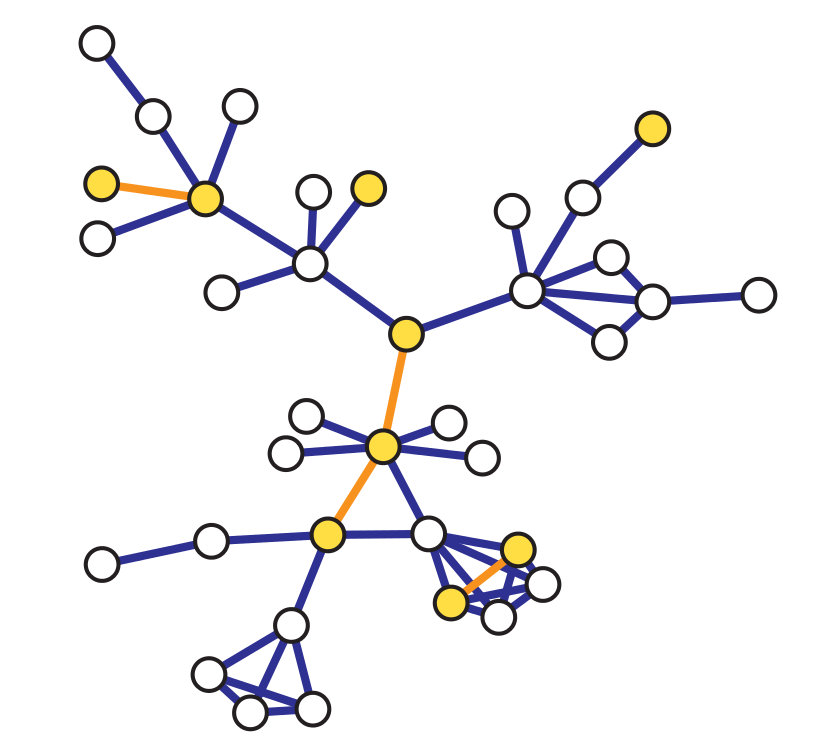
Induced subgraph sampling consists in drawing at random \(n\) vertices from a graph of order \(N_v\). In particular, let us denote with \(G = (V,E)\) the original graph and with \(G_s = (V_s,E_s)\) the sampled (sub)graph. Then, the set \(V_s\) includes the \(n\) nodes randomly drawn from \(V\) and \(E_s\) contains all the edges \(e_{i,j}\) such that both \(i\) and \(j\) belong to \(V_s\).
In this case, the vertex inclusion probability is equal to \(\pi_i = \frac{n}{N_v};\) while the edge inclusion probability is equal to: \( \pi_{e_{i,j}} = \frac{n(n-1)}{N_v(N_v-1)}\), \(\forall i \in V\), and \(\forall e_{i,j} \in E\).
Vertex inclusion probability - proof#
Given that our sample size is \(n\), we can extract up to \(\binom{N_v}{n}\) different samples if we do not impose any contraint on whether or not a specific node is selected. However, if we do impose that node \(i\) has to be included, then the total number of possible samples becomes \(\binom{N_v-1}{n-1}\).
Therefore, the vertex inclusion probability of a generic node \(i\) is: $\( \pi_i = \frac{\binom{N_v-1}{n-1}}{\binom{N_v}{n}} = \frac{\frac{(N_v-1)!}{(n-1)!(N_v-n)!}}{\frac{N_v!}{n!(N_v-n)!}} = \frac{(N_v-1)!}{(n-1)!} \frac{n!}{N_v!} = \frac{n}{N_v} \)$
import networkx as nx
import numpy as np
import matplotlib.pyplot as plt
from matplotlib import rc
rc('axes', axisbelow=True)
rc('axes', fc='w')
rc('figure', fc='w')
rc('savefig', fc='w')
N = 1000
M = 50000
average_degree = 2*M/N
print(average_degree)
p = average_degree/(N-1)
G_er = nx.erdos_renyi_graph(N,p)
G_ws = nx.watts_strogatz_graph(N, int(average_degree), p=0.01)
print("Average degree ER:", np.mean(list(dict(G_er.degree()).values())))
print("Average degree WS:", np.mean(list(dict(G_ws.degree()).values())))
100.0
Average degree ER: 100.042
Average degree WS: 100.0
from numpy.random import choice
def induced_subgraph_sampling(A,n):
adj_list = from_adj_matrix_to_adj_list(A,is_directed=False)
nodes = list(adj_list.keys())
V_s = choice(nodes, size = n, replace=False)
E_s = {(node_i,node_j) if node_i < node_j else (node_j,node_i)
for node_i in V_s for node_j in adj_list[node_i] if node_j in V_s}
return V_s, E_s
def induced_subgraph_sampling(G, n):
"""
Samples an induced subgraph of `n` nodes from the input graph `G`.
Parameters
----------
G : networkx.Graph
The input graph from which the subgraph is sampled.
n : int
The number of nodes to include in the sampled induced subgraph.
Returns
-------
subgraph : networkx.Graph
The induced subgraph with `n` nodes and the edges among them.
Raises
------
ValueError
If `n` is larger than the number of nodes in the graph.
"""
# Ensure `n` is not larger than the number of nodes in G
if n > G.number_of_nodes():
raise ValueError("`n` must be less than or equal to the number of nodes in the graph.")
# Get the list of nodes in the graph
nodes = list(G.nodes())
# Randomly sample `n` nodes without replacement
sampled_nodes = np.random.choice(nodes, size=n, replace=False)
# Create an induced subgraph of G using the sampled nodes
subgraph = G.subgraph(sampled_nodes).copy()
return subgraph
pos = nx.circular_layout(G_ws)
fig, ax = plt.subplots(1,4,figsize=(18,4),dpi=200)
for ni,n in enumerate([50,100,200,500]):
subg = induced_subgraph_sampling(G_ws, n)
nx.draw(G_ws, pos, node_color='.4', node_size=50, alpha=0.5, edge_color='.6', width=0.6, ax=ax[ni])
nx.draw(subg, pos, node_color='red',node_size=20, edge_color='red', width=0.6, ax=ax[ni])
ax[ni].set_title(r'$n = %i$, $\langle k \rangle = %.1f$'%(n, np.mean(list(dict(subg.degree).values()))))
plt.suptitle(r'Induced Subgraph Sampling (Watts-Strogatz network, N=%i, $\langle k \rangle = %.1f$)'%(
G_ws.number_of_nodes(),average_degree),
y=1.05, fontsize='xx-large')
plt.show()

Estimate the average degree of the graph from the sampled graph#
To estimate \(M\) we can use the Horvitz-Thompson estimator:
Our individual \(i\) is the edge \(e_{i,j}\)
The total we want to estimate is: $\(\tau = M = \sum_i y_i = \sum_{e_{i,j}}1\)$
In our case, the edge inclusion probability is: $\( \pi_{e_{i,j}} = \frac{n(n-1)}{N_v(N_v-1)} ,\)$
Therefore we can estimate \(\hat{M}\) as:$\( \hat{\tau}_\pi = \sum_{e_{i,j} \in S} \frac{1}{\pi_{e_{i,j}}} = M_s\frac{N_v(N_v-1)}{n(n-1)} .\)$
Then, we can compute \(\hat{k}\) as: $\(\hat{k} = \frac{2\hat{M}}{N}.\)$
fig, ax = plt.subplots(1,2,figsize=(11,4),dpi=200,sharey=True,sharex=True)
plt.subplots_adjust(wspace=0.1)
cols = ['steelblue','mediumseagreen']
B = 200 # number of simulations
labels = ['ER','WS']
for a, G in enumerate([G_er, G_ws]):
av_degs = np.zeros(B)
for b in range(B):
n = 50
subg_G = induced_subgraph_sampling(G, n)
m = subg_G.number_of_edges()
prob_e = n*(n-1)/N/(N-1)
M_est = m/prob_e
av_degs[b] = 2*M_est/N
ax[a].hist(av_degs, 20, label=labels[a], color=cols[a], ec='.2', alpha=0.7)
degs_G = np.mean(list(dict(G.degree()).values()))
ax[a].vlines(degs_G, 0, 35, lw=3, label='True value', color='orange')
mu = np.mean(av_degs)
ax[a].vlines(mu, 0, 35, color='.1', lw=2, label='Estimated value', ls='--')
ax[a].legend()
ax[a].set_ylim(0,35)
plt.suptitle('Horvitz-Thompson estimator')
plt.show()

Estimation of Group Size#
To estimate the number of nodes of a graph from a sampled graph we can use the following capture-recapture estimator:
We sample two distinct graphs using the induced subgraph sampling design and we denote the number of nodes in the two graphs with \(n_1\) and \(n_2\), respectively;
We count the number of nodes that the two sampled graphs have in common (we denote this number with \(n_c\));
We estimate the number of nodes in the original graph using the estimator \( \hat{N_v} = \frac{n_1 n_2}{n_c}\).
B = 100 # Number of iterations
N = 1000 # True size of the network
nodes = list(range(N))
# Array to store network size estimates
N_est = np.zeros(B)
### Perform capture-recapture simulation
for b in range(B):
# Randomly sample the size of the first and second sample sets
n1 = np.random.randint(150, 200)
n2 = np.random.randint(150, 200)
# Randomly select nodes for the first and second samples
V_s1 = np.random.choice(nodes, size=n1, replace=False)
V_s2 = np.random.choice(nodes, size=n2, replace=False)
# Count the number of nodes in the intersection (recaptured nodes)
n_c = len(set(V_s1).intersection(V_s2))
# Estimate the network size if recaptured nodes exist; otherwise, set to NaN
N_est[b] = n1 * n2 / n_c if n_c > 0 else np.nan
# Filter out invalid estimates (NaN values)
N_est = N_est[np.isfinite(N_est)]
#################
fig, ax = plt.subplots(1, 1, figsize=(8, 5), dpi=150)
ax.hist(N_est, bins=25, color='.8', edgecolor='.2', alpha=0.7)
ax.vlines(N, 0, 15, linewidth=3, label='True value', color='orange')
mu = np.mean(N_est)
ax.vlines(mu, 0, 15, color='.1', linewidth=2, label='Estimated value', linestyle='--')
ax.legend()
ax.set_yticks(range(0,25,5))
ax.set_ylim(0, 15)
plt.show()

Incident Subgraph Sampling#
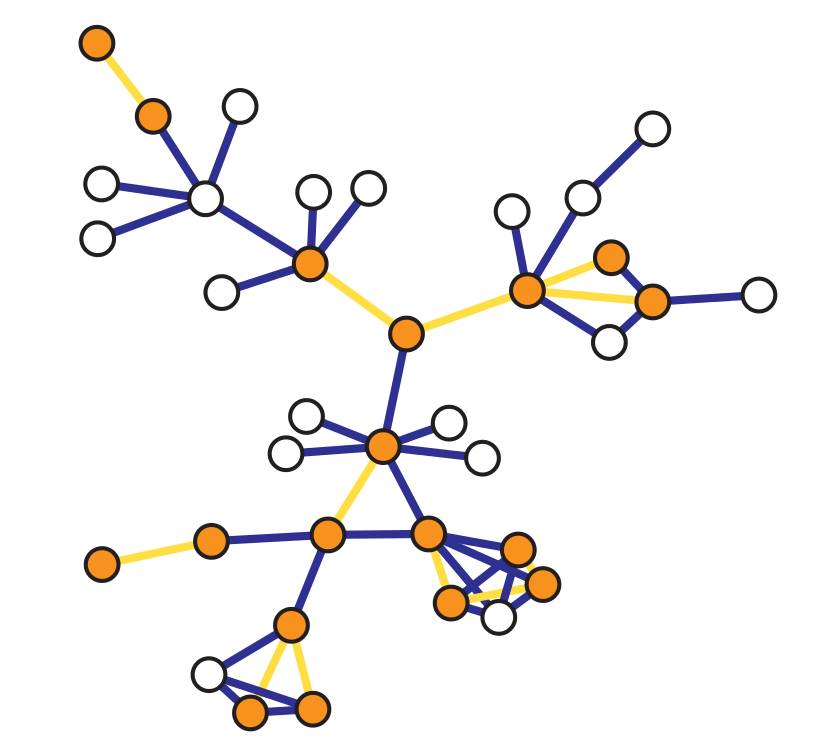
Incident subgraph sampling consists in drawing at random \(n\) edges from a graph of size \(N_e\). In particular, let us denote with \(G = (V,E)\) the original graph and with \(G_s = (V_s,E_s)\) the sampled (sub)graph. Then, the set \(E_s\) includes the \(n\) edges randomly selected from \(E\) and \(V_s\) contains all the nodes incident to the selected edges such that \(\forall e_{i,j} \in E_s\), \(i,j \in V_s\).
In this case, the vertex inclusion probability is equal to: $\( \pi_i = \begin{cases} 1 - \frac{\binom{N_e - k_i}{n}}{\binom{N_e}{n}}, \text{ if } n\leq N_e - k_i\\ 1, \text{ if } n > N_e - k_i \end{cases} \)\( while the _edge inclusion probability_ is equal to: \)\( \pi_{e_{i,j}} = \frac{n}{N_e} ,\)$
\(\forall i \in V\), and \(\forall e_{i,j} \in E\).
Notice that \(\pi_i\) is computed as one minus the probability of not sampling an edge incident to \(i\).
from random import shuffle
def incident_subgraph_sampling(G, n, is_directed=False):
"""
Samples an incident subgraph containing `n` edges from the input graph `G`.
Parameters
----------
G : networkx.Graph or networkx.DiGraph
The input graph from which the subgraph is sampled.
n : int
The number of edges to include in the sampled incident subgraph.
is_directed : bool, optional (default=False)
Specifies if the graph is directed. If True, edges are treated as directed.
Returns
-------
subgraph : networkx.Graph or networkx.DiGraph
The incident subgraph with `n` edges and the nodes connected by those edges.
Raises
------
ValueError
If `n` is larger than the number of edges in the graph.
"""
# Ensure `n` is not larger than the number of edges in G
if n > G.number_of_edges():
raise ValueError("`n` must be less than or equal to the number of edges in the graph.")
# Get the list of edges in the graph
edges = list(G.edges())
# Shuffle the edges randomly to sample from them
shuffle(edges)
# Select the first `n` edges from the shuffled list
sampled_edges = edges[:n]
# Find the unique nodes connected by the sampled edges
sampled_nodes = set(node for edge in sampled_edges for node in edge)
# Create a new subgraph with the sampled nodes and edges
subgraph = G.edge_subgraph(sampled_edges).copy()
return subgraph
Let’s look at an example where we randomly assign nodes to group labels in a network#
N = 1000
G = nx.barabasi_albert_graph(N,10)
pos = nx.spring_layout(G)
print("Average degree: %1.1f" % np.mean(list(dict(G.degree()).values())))
M = G.number_of_edges()
print("Number of edges:", M)
Average degree: 19.8
Number of edges: 9900
prob_red = 0.7
reds = 0
blues = 0
for node in G.nodes():
G.nodes[node]['team'] = 'red' if np.random.rand() < prob_red else 'blue'
if G.nodes[node]['team'] == 'red':
reds += 1
else:
blues += 1
print("Number of red nodes:",reds)
print("Number of blue nodes:",blues)
Number of red nodes: 702
Number of blue nodes: 298
fig, ax = plt.subplots(1,1,figsize=(5,5),dpi=100)
nx.draw(G, pos=pos, node_color=nx.get_node_attributes(G, 'team').values(),ax=ax,node_size=50, edge_color='.6')
plt.show()

from scipy.special import binom
def prob_i(N_e, k_i, n):
"""
Calculate the probability of at least one sample overlapping with node i.
Parameters:
N_e : int
Effective size of the network.
k_i : int
Number of samples that do not include node i.
n : int
Number of nodes in the sample.
Returns:
float
Probability of at least one sample overlapping with node i.
"""
# If the sample size exceeds the available nodes excluding k_i,
# the probability is 1 (certain inclusion).
if n > N_e - k_i:
return 1.0
# Otherwise, calculate the complement of the probability that node i is not sampled.
return 1.0 - binom(N_e - k_i, n) / binom(N_e, n)
# We use the Horovitz-Thompson estimator to get those numbers from sampled graphs
B = 1000
reds_est = [None]*B
blues_est = [None]*B
degrees = dict(G.degree())
for b in range(B):
n = 100
G_s = incident_subgraph_sampling(G,n)
V_s = list(G_s.nodes())
E_s = list(G_s.edges())
pi = {node: prob_i(M,degrees[node],n) for node in V_s}
reds_est[b] = sum([ 1.0/pi[node] for node in V_s if G.nodes[node]['team'] == 'red'])
blues_est[b] = sum([ 1.0/pi[node] for node in V_s if G.nodes[node]['team'] == 'blue'])
fig, ax = plt.subplots(1,1,figsize=(12,5),dpi=200)
ax.hist(reds_est, bins=50, color='crimson', alpha=0.4, label='Estimated average reds: %.2f'%(np.mean(reds_est)))
ax.hist(blues_est, bins=50, color='steelblue', alpha=0.4, label='Estimated average blues: %.2f'%(np.mean(blues_est)))
ax.vlines(reds, 0, 100, color='crimson', ls='--', label='True reds: %i'%reds)
ax.vlines(blues, 0, 100, color='steelblue', ls='--', label='True blues: %i'%blues)
ax.legend(loc=2)
ax.set_ylim(0,100)
plt.show()

def get_binning(data, num_bins=50, is_pmf=False, log_binning=False, threshold=0):
"""
Bins the input data and calculates the probability mass function (PMF) or
probability density function (PDF) over the bins. Supports both linear and
logarithmic binning.
Parameters
----------
data : array-like
The data to be binned, typically a list or numpy array of values.
num_bins : int, optional
The number of bins to use for binning the data (default is 15).
is_pmf : bool, optional
If True, computes the probability mass function (PMF) by normalizing
histogram counts to sum to 1. If False, computes the probability density
function (PDF) by normalizing the density of the bins (default is True).
log_binning : bool, optional
If True, uses logarithmic binning with log-spaced bins. If False, uses
linear binning (default is False).
threshold : float, optional
Only values greater than `threshold` will be included in the binning,
allowing for the removal of isolated nodes or outliers (default is 0).
Returns
-------
x : numpy.ndarray
The bin centers, adjusted to be the midpoint of each bin.
p : numpy.ndarray
The computed PMF or PDF values for each bin.
Notes
-----
This function removes values below a specified threshold, then defines
bin edges based on the specified binning method (linear or logarithmic).
It calculates either the PMF or PDF based on `is_pmf`.
"""
# Filter out isolated nodes or low values by removing data below threshold
values = list(filter(lambda x: x > threshold, data))
if len(values) != len(data):
print("%s isolated nodes have been removed" % (len(data) - len(values)))
# Define the range for binning (support of the distribution)
lower_bound = min(values)
upper_bound = max(values)
# Define bin edges based on binning type (logarithmic or linear)
if log_binning:
# Use log-spaced bins by taking the log of the bounds
lower_bound = np.log10(lower_bound)
upper_bound = np.log10(upper_bound)
bin_edges = np.logspace(lower_bound, upper_bound, num_bins + 1, base=10)
else:
# Use linearly spaced bins
bin_edges = np.linspace(lower_bound, upper_bound, num_bins + 1)
# Calculate histogram based on chosen binning method
if is_pmf:
# Calculate PMF: normalized counts of data in each bin
y, _ = np.histogram(values, bins=bin_edges, density=False)
p = y / y.sum() # Normalize to get probabilities
else:
# Calculate PDF: normalized density of data in each bin
p, _ = np.histogram(values, bins=bin_edges, density=True)
# Compute bin centers (midpoints) to represent each bin
x = bin_edges[1:] - np.diff(bin_edges) / 2 # Bin centers for plotting
# Remove bins with zero probability to avoid plotting/display issues
x = x[p > 0]
p = p[p > 0]
return x, p
M = 50000
N = 10000
G = nx.gnm_random_graph(N,M)
degrees = list(dict(G.degree()).values())
print("Average degree: %1.3f" % np.mean(degrees))
n = 5000
Average degree: 10.000
# Using Incident Graph Sampling
G_incid = incident_subgraph_sampling(G, n)
degrees_incid = list(dict(G_incid.degree()).values())
x_incid,y_incid = get_binning(degrees_incid, log_binning=True)
# True Degree distribution
x_true,y_true = get_binning(degrees, log_binning=True)
1 isolated nodes have been removed
fig, ax = plt.subplots(1,1,figsize=(7,5),dpi=100)
ax.loglog(x_true,y_true,'o', label='Original Graph')
ax.loglog(x_incid, y_incid, 'o', label='Incident Graph Sampling')
ax.legend()
ax.set_xlabel(r'$k$',fontsize='x-large')
ax.set_ylabel(r'$P(k)$',fontsize='x-large')
plt.show()
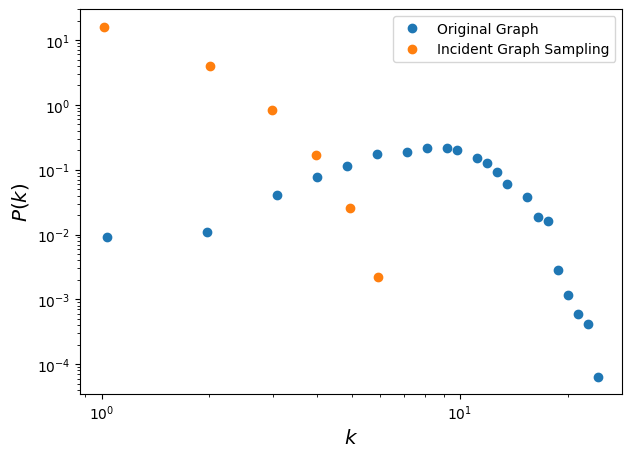
Edge Sampling with Graph Induction (ES-i)#
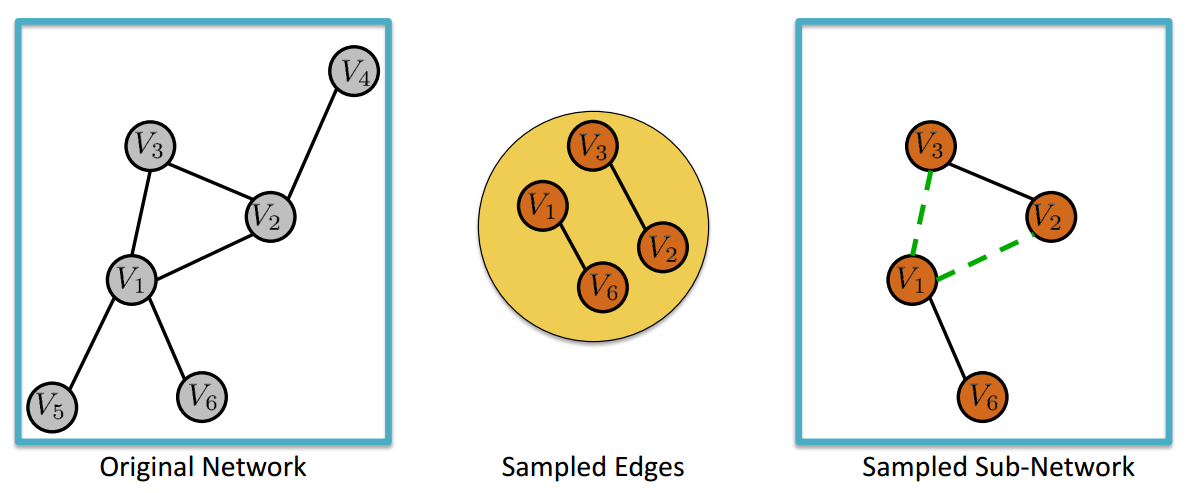
Edge Sampling with Graph Induction consists in drawing at random \(n\) edges from a graph of size \(N_e\). In partiuclar, let us denote with \(G = (V,E)\) the original graph and with \(G_s = (V_s,E_s)\) the sampled (sub)graph. Then, \(V_s\) contains all the nodes incident to the randomly selected edges and \(E_s\) comprises the \(n\) edges randomly selected from \(E\) plus all the other edges \(e_{i,j} \in E\) such that that both \(i\) and \(j\) belong to \(V_s\).
Some observations:
Edge sampling is inherently biased towards selection of nodes with higher degrees resulting in an upward bias in the degree distributions of sampled nodes compared to nodes in the original graph
In sampled subgraphs degrees are naturally underestimated since only a fraction of neighbors may be selected. This results in a downward bias, regardless of the actual sampling algorithm used.
The upward bias of edge sampling can help offset this downward bias to some extent, it alone is not sufficient to fully offset the bias.
Then, a simple graph induction step over the edge-sampled node set (where we sample all the edges between any sampled nodes in the graph) can recover much of the connectivity around the high degree nodes offsetting the downward degree bias as well as improving local clustering in the sampled graph.
def edge_sampling_with_induction(G, n):
"""
Perform edge sampling with induction and return a new graph.
Parameters:
G : networkx.Graph
Input graph.
n : int
Number of edges to sample initially.
Returns:
networkx.Graph
A new graph induced by the sampled nodes and edges.
"""
# Get all edges and total number of edges in the graph
edges = list(G.edges())
M = G.number_of_edges()
# Sample n edges randomly without replacement
sampled_edges = set([edges[i] for i in np.random.permutation(M)[:n]])
# Extract the set of nodes in the sampled edges
nodes_from_sampled_edges = set(node for edge in sampled_edges for node in edge)
# Induce edges between the sampled nodes
induced_edges = set(sampled_edges)
for node_i, node_j in edges:
if node_i in nodes_from_sampled_edges and node_j in nodes_from_sampled_edges:
induced_edges.add((node_i, node_j))
# Create a new graph with the sampled nodes and induced edges
new_graph = nx.Graph()
new_graph.add_nodes_from(nodes_from_sampled_edges)
new_graph.add_edges_from(induced_edges)
return new_graph
G_esi = edge_sampling_with_induction(G, n)
degrees_esi = list(dict(G_esi.degree()).values())
x_esi,y_esi = get_binning(degrees_esi, log_binning=True)
fig, ax = plt.subplots(1,1,figsize=(7,5),dpi=100)
ax.loglog(x_true, y_true, 'o', label='Original Graph')
ax.loglog(x_incid, y_incid, 'o', label='Incident Graph Sampling')
ax.loglog(x_esi, y_esi, 'o', label='Edge-Sampling w/ Induction')
ax.legend()
ax.set_xlabel(r'$k$',fontsize='x-large')
ax.set_ylabel(r'$P(k)$',fontsize='x-large')
plt.show()

Why is this working better?#
Standard edge sampling (i.e. incident subgraph sampling) is biased towards selection of high degree nodes. Therefore, the sampled degree distribution is upward biased with respect to the original graph. However, in all sampled subgraphs, degrees are actually underestimated because only a fraction of neighbors may be selected.
As a consequence, there is a downward bias, regardless of the actual sampling algorithm used. Incident subgraph sampling alone is not enough to correct for this downward bias since it samples each edge independently and it is therefore unlikely to preserve local nodes connectivity.
By adding the additional graph induction step, not only local clustering is improved, but it is also easier to reconstruct the connectivity of (high degree) nodes.
from scipy.stats import ks_2samp
def ks_d(values1, values2):
"""
Compute the Kolmogorov-Smirnov (KS) statistic to compare two distributions.
Parameters:
values1 : array-like
First sample of values.
values2 : array-like
Second sample of values.
Returns:
float
KS statistic (D), representing the maximum distance between the empirical
cumulative distribution functions (ECDFs) of the two samples.
"""
D, _ = ks_2samp(values1, values2)
return D
print('Original vs ES-i:', ks_d(degrees, degrees_esi))
print('Original vs Incident Graph Sampling:', ks_d(degrees, degrees_incid))
Original vs ES-i: 0.37899360163496304
Original vs Incident Graph Sampling: 0.9652937421777221
Snowball Sampling#
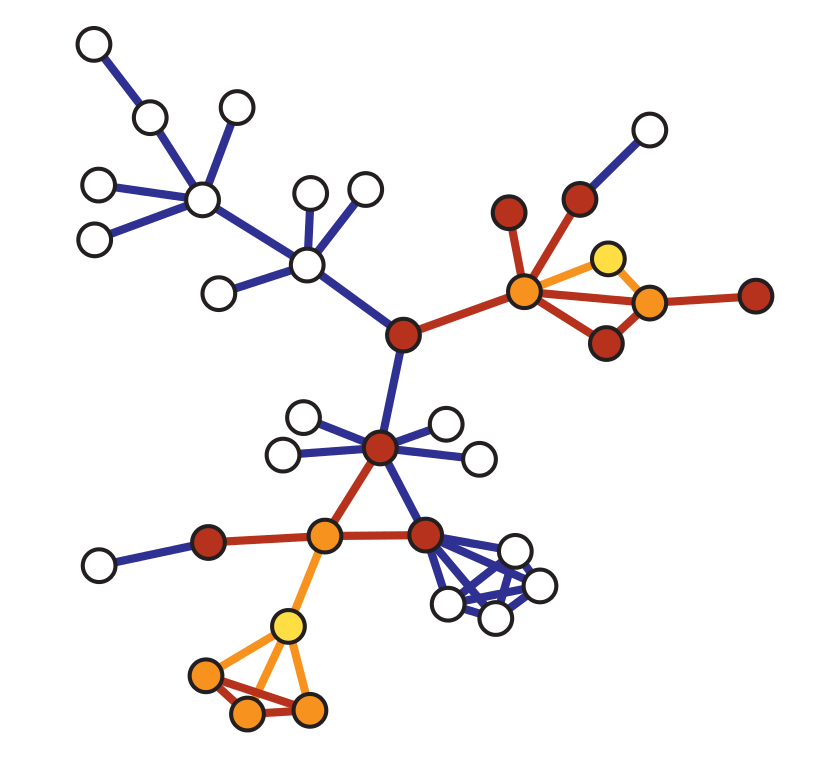
Snowball sampling extends the labeled star sampling procedure. In particular, it consists in drawing at random \(n\) nodes from a graph of order \(N_v\). Let us denote this initial set of nodes with \(V_{s,0}\) and with \(\mathbb{V}(S)\) the set of all neighbors of the vertices in the a given set \(S\). Then, a \(k\)-wave snowball sampling algorithm simply extends the initial set of nodes \(V_{s,0}\) \(k\) times in the following way:
\(V_{s,1} = \mathbb{V}(V_{s,0}) \cap \bar{V}_{s,0}\),
\(V_{s,2} = \mathbb{V}(V_{s,1}) \cap \bar{V}_{s,1} \cap \bar{V}_{s,0}\),
…
\(V_{s,k} = \mathbb{V}(V_{s,k-1}) \cap \bar{V}_{s,k-1} \cap \dots \cap \bar{V}_{s,0}\).
When the degree distribution of the original network is power-law, it is found that the estimated degree exponent decreases with snowball sampling as we decrease the sampling fraction.
Sampled networks are shown to be more disassortative than the original networks. This pattern is common no matter whether the original network is assortative, disassortative, or neutral.
def snowball_sampling(G, seed_nodes, n_waves=2):
"""
Perform snowball sampling on a graph.
Parameters:
G : networkx.Graph or networkx.DiGraph
Input graph.
seed_nodes : list or set
Initial set of nodes to start the snowball sampling.
n_waves : int, optional
Number of waves to expand the snowball sampling (default is 2).
Returns:
networkx.Graph or networkx.DiGraph
A new graph G_s containing the sampled nodes and edges.
"""
# Initialize sets to keep track of sampled nodes and edges
V_s = set(seed_nodes)
E_s = set()
# Initialize the wave structure
V = [set()] * (n_waves + 1)
V[0] = set(seed_nodes)
# Perform snowball sampling over the specified number of waves
for k in range(n_waves):
V[k + 1] = set() # Initialize the next wave
for node_i in V[k]:
for node_j in G.neighbors(node_i):
# Add the edge to the sampled edge set
edge = (node_i, node_j) if not G.is_directed() and node_i < node_j else (node_i, node_j)
E_s.add(edge)
# Add the neighboring node to the next wave
V[k + 1].add(node_j)
# Exclude nodes already in the sampled set
V[k + 1] -= V_s
# Add new nodes to the sampled set
V_s.update(V[k + 1])
# Create the new sampled graph
G_s = G.subgraph(V_s).copy()
return G_s
N = 15000
m = 3
G = nx.barabasi_albert_graph(N, m)
M = G.number_of_nodes()
degrees = list(dict(G.degree()).values())
print(M)
15000
fig, ax = plt.subplots(1,1,figsize=(10, 5), dpi=200)
n = 50 # Number of seed nodes
n_waves = 5 # Maximum number of waves
degrees_sampled = [None] * (n_waves + 1)
nodes = list(G.nodes())
# Perform snowball sampling for increasing numbers of waves
for k in range(n_waves + 1):
# Select seed nodes randomly
seed_nodes = set(np.random.choice(nodes, size=n, replace=False))
# Perform snowball sampling
G_s = snowball_sampling(G, seed_nodes, n_waves=k)
# Print summary of the sampled graph
print(f"Number of waves: {k} | Number of nodes discovered: {G_s.number_of_nodes()} | "
f"Number of edges discovered: {G_s.number_of_edges()}")
# Get degree distribution of the sampled graph
degrees_sampled[k] = [deg for _, deg in G_s.degree()]
# Plot degree distribution for the current wave
if k > 0:
x1, y1 = get_binning(degrees_sampled[k], log_binning=True, num_bins=15, is_pmf=False)
ax.loglog(x1, y1, '--o', label=f'Wave: {k}')
# Plot the degree distribution of the original graph
x, y = get_binning(degrees, log_binning=True, num_bins=15, is_pmf=False)
ax.scatter(x, y, s=100, facecolors='none', edgecolors='r', lw=3, label='Original Graph')
ax.legend()
ax.set_xlabel(r'$k$',fontsize='x-large')
ax.set_ylabel(r'$P(k)$',fontsize='x-large')
plt.show()
Number of waves: 0 | Number of nodes discovered: 50 | Number of edges discovered: 1
Number of waves: 1 | Number of nodes discovered: 369 | Number of edges discovered: 439
Number of waves: 2 | Number of nodes discovered: 4068 | Number of edges discovered: 8916
Number of waves: 3 | Number of nodes discovered: 13001 | Number of edges discovered: 37972
Number of waves: 4 | Number of nodes discovered: 14998 | Number of edges discovered: 44985
Number of waves: 5 | Number of nodes discovered: 15000 | Number of edges discovered: 44991
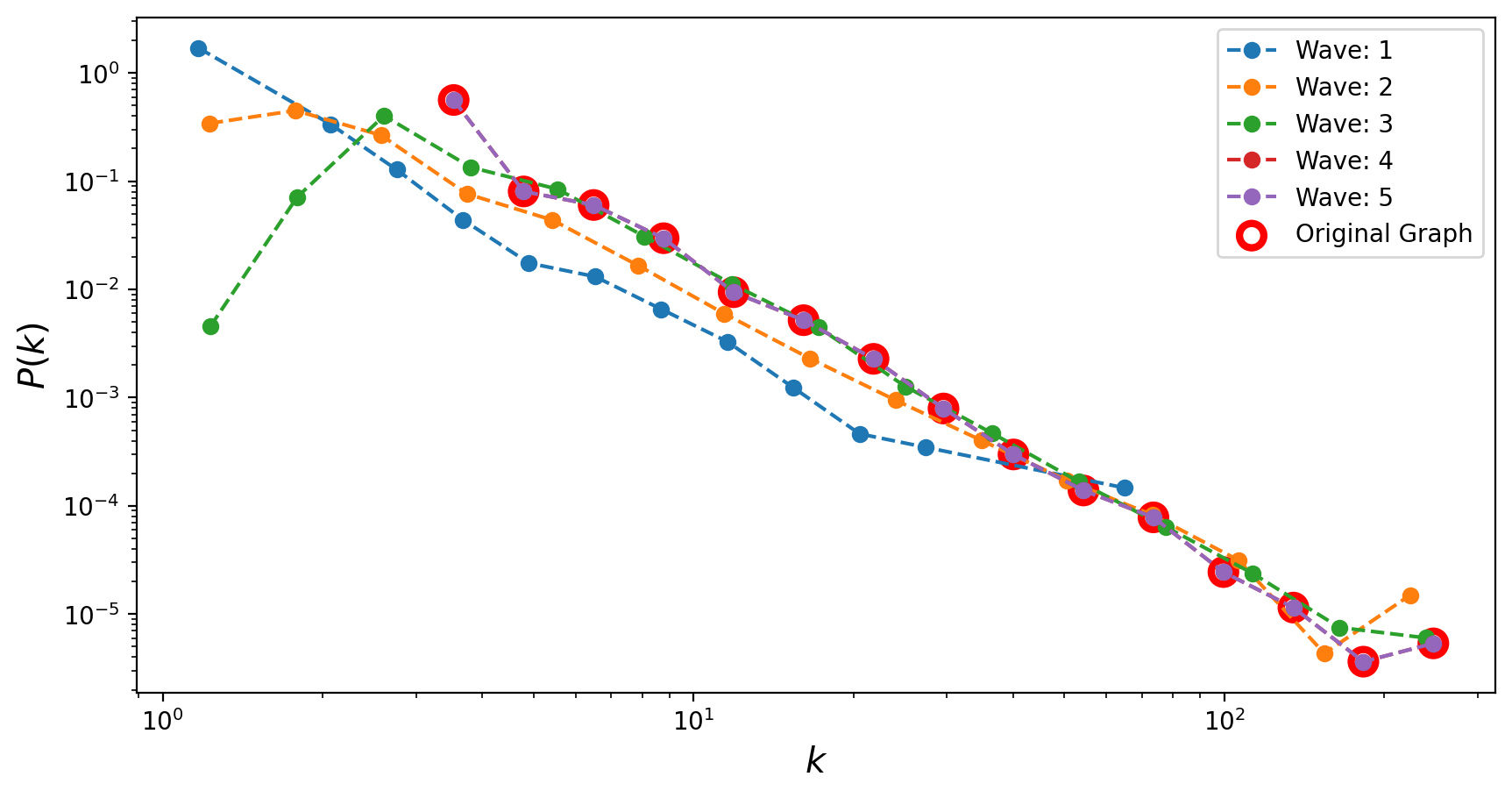
Traceroute Sampling#
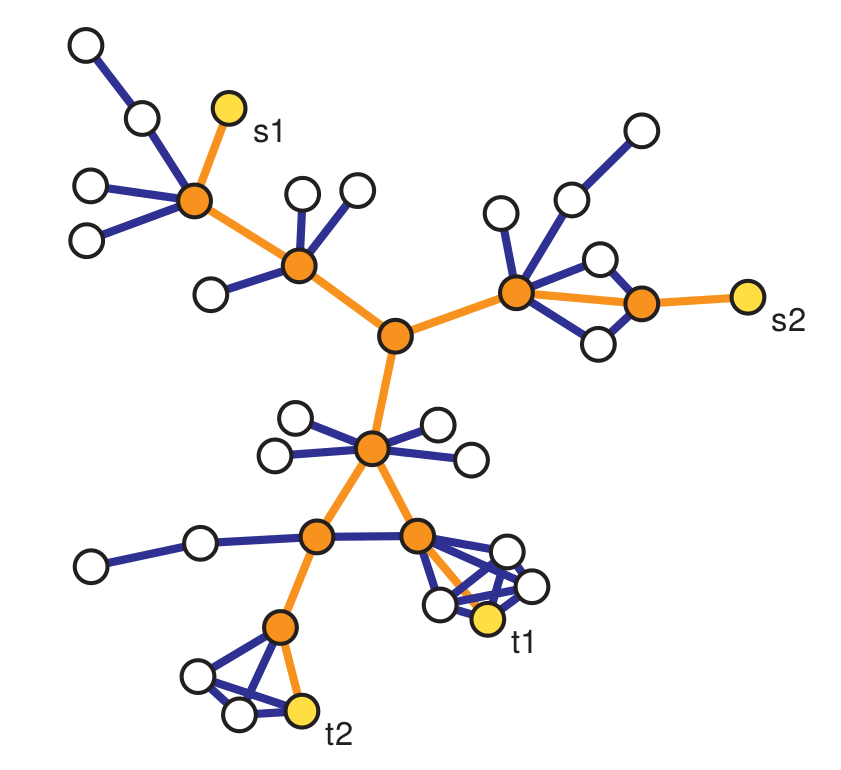
Traceroute sampling is an example of a link tracing algorithm used to generate sampled graphs. In traceroute sampling, two initial disjoint sets of nodes are drawn at random: a set of sources \(V_S\) of cardinality \(n_S\) and a set of targets \(V_T\) of cardinality \(n_T\). Then, a route is traced from each node in \(V_S\) to each node in \(V_T\) and all vertices and edges encountered are added to \(V_s\) and \(E_s\), respectively. Then, the sampled graph is \(G_s = (V_s,E_s)\).
If the source and target sets are obtained using a simple random sampling without replacement and the route considered is simply the shortest path between each pair of vertices, then the vertex inclusion probability can be approximated with: $\( \pi_i \approx 1 - \left(1 - \frac{n_S}{N_v} - \frac{n_T}{N_v}\right)\exp\left(-b_i\frac{n_S}{N_v}\frac{n_T}{N_v}\right) ;\)\( while the _edge inclusion probability_ can be approximated with: \)\( \pi_{e_{i,j}} \approx 1 - \exp\left(-b_{e_{i,j}}\frac{n_S}{N_v}\frac{n_T}{N_v}\right) ;\)\( where \)b_i\( is the betweenness centrality of vertex \)i\( and \)b_{e_{i,j}}\( is the betweenness centrality of edge \)e_{i,j}$.
Traceroute sampling can make power laws appear where none existed in the underlying graph (even in the extreme case of regular random graphs)
Even when the original degree distribution is power-law, traceroute sampling significantly underestimate the tail exponent
# def traceroute_sampling(G,n_sources=5,n_targets=50):
# nodes = G.nodes()
# shuffle(nodes)
# sources = set(nodes[:n_sources])
# targets = set(nodes[n_sources:(n_sources+n_targets)])
# paths = [nx.shortest_path(G, source=source_node, target=target_node)
# for source_node in sources for target_node in targets]
# V_s = set()
# E_s = set()
# for path in paths:
# V_s.add(path[0])
# for i in xrange(1,len(path)):
# V_s.add(path[i])
# E_s.add((path[i-1],path[i]))
# return (V_s, list(E_s))
def traceroute_sampling(G, n_sources=5, n_targets=50):
"""
Perform traceroute sampling on a graph, selecting multiple sources and targets.
Parameters:
G : networkx.Graph
Input graph.
n_sources : int, optional
Number of source nodes (default is 5).
n_targets : int, optional
Number of target nodes (default is 50).
Returns:
networkx.Graph
A new graph containing the sampled nodes and edges.
"""
nodes = list(G.nodes())
shuffle(nodes)
# Select sources and targets
sources = set(nodes[:n_sources])
targets = set(nodes[n_sources:n_sources + n_targets])
# Initialize the sampled graph
G_s = nx.Graph() if not G.is_directed() else nx.DiGraph()
# Compute shortest paths from each source to each target
for source_node in sources:
for target_node in targets:
try:
path = nx.shortest_path(G, source=source_node, target=target_node)
G_s.add_nodes_from(path)
G_s.add_edges_from((path[i], path[i + 1]) for i in range(len(path) - 1))
except nx.NetworkXNoPath:
pass # Ignore if no path exists
return G_s
Bias reduction in Traceroute Sampling#
We can use the capture-recapture estimator to improve the sampled degree distribution (see Flaxman, A. D., & Vera, J., 2007).
Let us denote with \(U\) the set of sources we are using to perform the traceroute sampling and with \(G_{u_1}\) and \(G_{u_2}\) two sampled graphs obtained using source nodes \(u_1\) and \(u_2\), respectively. Then, we can estimate the degree of a generic node \(i\) in the sampled graph \(G_{u_1}\) as:
Then, we can repeat the same procedure for all the pairs of sources in \(U\) and obtain the final estimate for the degree of node \(i\) as:
def traceroute_sampling_revised(G, source_node, n_targets=50):
"""
Perform traceroute sampling from a single source to multiple targets.
Parameters:
G : networkx.Graph
Input graph.
source_node : node
Source node to start the traceroute.
n_targets : int, optional
Number of target nodes (default is 50).
Returns:
networkx.Graph
A new graph containing the sampled nodes and edges.
"""
nodes = list(G.nodes())
# Remove the source node from the list of potential targets
nodes.remove(source_node)
shuffle(nodes)
# Select targets
targets = set(nodes[:n_targets])
# Initialize the sampled graph
G_s = nx.Graph() if not G.is_directed() else nx.DiGraph()
# Compute shortest paths from the source to each target
for target_node in targets:
try:
path = nx.shortest_path(G, source=source_node, target=target_node)
G_s.add_nodes_from(path)
G_s.add_edges_from((path[i], path[i + 1]) for i in range(len(path) - 1))
except nx.NetworkXNoPath:
pass # Ignore if no path exists
return G_s
# Graph parameters
N = 1000
k = 15.0
M = int(0.5 * N * k)
G = nx.gnm_random_graph(N, M)
degrees = [deg for _, deg in G.degree()] # Original degree distribution
# Traceroute sampling parameters
n_sources = 8
share_nodes = []
share_edges = []
sampled_degrees = []
sampled_clustering = []
N_targets = np.arange(50, 261, 50)
# Perform traceroute sampling for different numbers of targets
for n_targets in N_targets:
sampled_graph = traceroute_sampling(G, n_sources, n_targets) # Updated function returns the graph directly
# Compute metrics
share_nodes.append(sampled_graph.number_of_nodes() / float(N))
share_edges.append(sampled_graph.number_of_edges() / float(M))
sampled_degrees.append([deg for _, deg in sampled_graph.degree()])
sampled_clustering.append(list(nx.clustering(sampled_graph).values()))
# Plot share of nodes and edges
plt.figure(figsize=(16, 5))
plt.plot(N_targets, share_nodes, label='Share nodes')
plt.plot(N_targets, share_edges, label='Share edges')
plt.xlabel("Number of Targets")
plt.ylabel("Proportion")
plt.legend()
plt.title("Share of Nodes and Edges by Number of Targets")
plt.show()
# Plot degree distributions
plt.figure(figsize=(16, 5))
for k, values in enumerate(sampled_degrees):
x, y = get_binning(values, log_binning=True, num_bins=30)
plt.loglog(x, y, 'o', label=f"Number of targets: {N_targets[k]}")
# Plot original degree distribution
x, y = get_binning(degrees, log_binning=True, num_bins=30)
plt.loglog(x, y, 'o', label="Original")
plt.xlabel("Degree")
plt.ylabel("Frequency")
plt.legend()
plt.title("Degree Distribution")
plt.show()
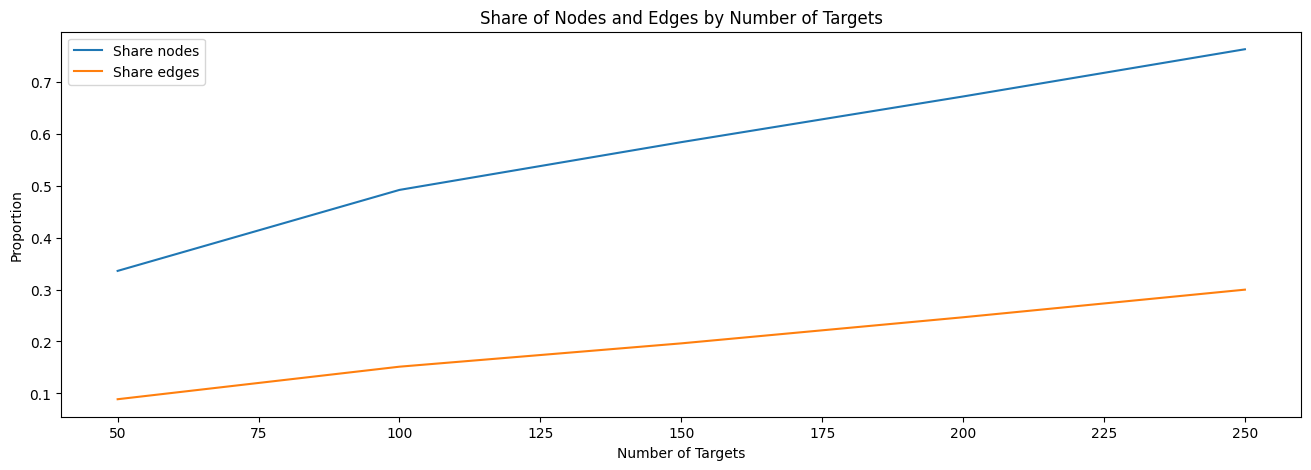
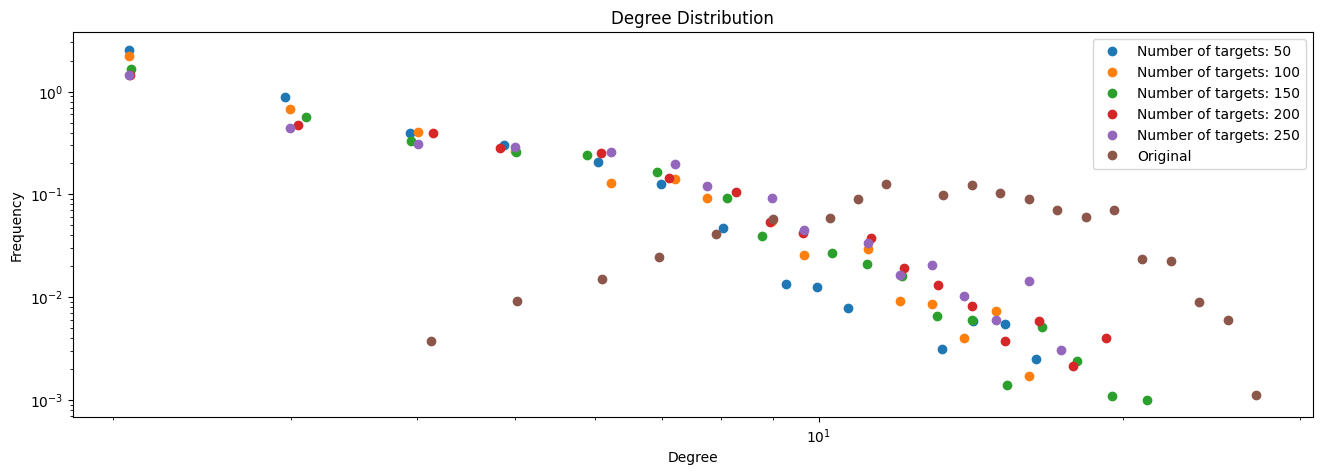
from collections import defaultdict
from itertools import combinations
# Parameters
n_sources = 8
n_targets = 100
B = 200
degree = defaultdict(list)
# Run sampling iterations
for b in range(B):
# print(f"Iteration {b + 1}/{B}")
# Shuffle and select source nodes
nodes = list(G.nodes())
np.random.shuffle(nodes)
source_nodes = nodes[:n_sources]
# Perform traceroute sampling for each source node
sampled_graphs = [traceroute_sampling_revised(G, source_node, n_targets) for source_node in source_nodes]
# Generate all pairs of sampled graphs
pairs = combinations(sampled_graphs, 2)
for sampled_graph1, sampled_graph2 in pairs:
for u in sampled_graph1.nodes:
# Get neighbors in both sampled graphs
neigh1 = set(sampled_graph1.neighbors(u))
if u in sampled_graph2:
neigh2 = set(sampled_graph2.neighbors(u))
# Compute the degree estimation based on shared neighbors
N_c = float(len(neigh1.intersection(neigh2)))
if N_c > 2:
degree[u].append(len(neigh1) * len(neigh2) / N_c)
# Compute degree estimates
degree_est = [np.median(values) for values in degree.values()]
# Plotting
plt.figure(figsize=(16, 5))
for k, values in enumerate(sampled_degrees):
x,y = get_binning(values, log_binning=True, num_bins=30)
__ = plt.loglog(x,y, 'o', label = "Number of targets: %d" % N_targets[k])
# Original degree distribution
x, y = get_binning(degrees, log_binning=True, num_bins=30)
plt.loglog(x, y, '-o', label="Original")
# Bias-corrected degree estimates
x, y = get_binning(degree_est, log_binning=True, num_bins=30)
plt.loglog(x, y, '-o', label="Bias Correction")
plt.legend()
plt.show()

Random Walk Sampling#
Random Walk sampling is another example of a link tracing algorithm used to generate sampled graphs. The classic algorithm works as follows:
we start from a random vertex \(i_0\);
at each \(t_{th}\) step of the walk, given that we are at node \(i_t\), we move to one of \(i_t\) neighbors with equal probability (i.e. if \(k_{i_t}\) is the degree of node \(i_t\), we pick one of its neighbors wiht probability \(1/k_{i_t}\)).
Then, \(V_s\) will include all the nodes visited during the random walk, while \(E_s\) will include all the edges traversed.
It can be shown that the probability of being at a particular node \(i\) converges to the stationary distribution: $\( \pi_i = \frac{k_i}{2M}.\)$
However, in practice, we may allow for the fact that the graph is not connected and that our random walker might get stucked. If that is the case, we can randomly select a different starting node for the remaining steps. Lastly, we can allow for the possibility that the random walker “flies back” to the original node and re-starts walking from there.
def random_walk_sampling(G, n, n0=10, fly_back=0.15, jump_after=10):
"""
Perform random walk sampling on a graph.
Parameters:
G : networkx.Graph
Input graph.
n : int
Target number of nodes to sample.
n0 : int, optional
Number of initial walkers (default is 10).
fly_back : float, optional
Probability of flying back to the starting node (default is 0.15).
jump_after : int, optional
Number of consecutive steps stuck before restarting (default is 10).
Returns:
networkx.Graph
A new graph G_s containing the sampled nodes and edges.
"""
# Initialize sampled nodes and edges
nodes = list(G.nodes())
shuffle(nodes)
V0 = nodes[:n0] # Initial walker positions
V_s = set(V0)
E_s = set()
# State variables for each walker
current_position = V0[:]
prev_position = [-1] * n0
stuck = [0] * n0
for k in range(n0):
while len(V_s) < n:
# Check if walker is stuck
if current_position[k] == prev_position[k]:
stuck[k] += 1
if stuck[k] > jump_after:
shuffle(nodes)
current_position[k] = nodes[0]
stuck[k] = 0
# Select a random neighbor for the next step
neighbors = list(G.neighbors(current_position[k]))
if not neighbors: # Handle isolated nodes
continue
shuffle(neighbors)
# Update positions
prev_position[k] = current_position[k]
current_position[k] = neighbors[0]
# Add the new node and edge to the sampled set
V_s.add(current_position[k])
edge = (current_position[k], prev_position[k]) if current_position[k] > prev_position[k] \
else (prev_position[k], current_position[k])
E_s.add(edge)
# Fly back to the starting node with a given probability
if np.random.rand() <= fly_back:
current_position[k] = V0[k]
# Create the new sampled graph
G_s = nx.Graph() if not G.is_directed() else nx.DiGraph()
G_s.add_nodes_from(V_s)
G_s.add_edges_from(E_s)
return G_s
N = 10000
G = nx.barabasi_albert_graph(N,5)
M = G.number_of_edges()
degrees = list(dict(G.degree()).values())
clustering = list(nx.clustering(G).values())
plt.figure(figsize=(16, 5))
n = 100 # Target sample size
n0 = 10 # Number of walkers
fly_back = 0.15
jump_after = 10
degrees_sampled = []
for k in range(1, 6): # Number of waves or attempts
G_s = random_walk_sampling(G, n=n, n0=n0, fly_back=fly_back, jump_after=jump_after)
degrees_sampled.append([deg for _, deg in G_s.degree()])
x, y = get_binning(degrees_sampled[-1], log_binning=True, num_bins=15, is_pmf=False)
__ = plt.loglog(x, y, '--o', label=f'Sampling: Wave {k}')
# Original graph degree distribution
degrees = [deg for _, deg in G.degree()]
x, y = get_binning(degrees, log_binning=True, num_bins=15, is_pmf=False)
__ = plt.scatter(x, y, s=100, facecolors='none', edgecolors='r', lw=3, label='Original Graph')
plt.legend()
plt.show()
9 isolated nodes have been removed
9 isolated nodes have been removed
9 isolated nodes have been removed
9 isolated nodes have been removed
9 isolated nodes have been removed

Re-Weighted Random Walk#
One way to correct the bias towards high node degrees of the classic random walk is to re-weight the observed degree distribution of the sampled graph after running the random walk sampling: $\( \hat{p}(k) = \frac{\sum_{\{i \in V_s | k_i = k \}} 1/k_i }{\sum_{j \in V_s} 1/k_j } .\)$
Metropolis-Hastings Random Walk Sampling#
The classic random walk sampling algorithm is biased towards high degree nodes. One way to correct for this bias it to use Metropolis-Hastings random walk sampling. Metropolis-Hastings random walk sampling algorithm works as follows:
we start from a random vertex \(i_0\);
at each \(t_{th}\) step of the walk, given that we are at node \(i_t\), we select at random one of \(i_t\) neighbors (let us denote this node with \(w\));
we generate a random number \(0\leq r \leq 1\);
if \(r \leq \frac{k_{i_t}}{k_{w}}\) then we accept the move, otherwise we stay at node \(i_t\) and we go back to 2.
It can be shown that the probability of being at a particular node \(i\) converges to the stationary distribution: $\( \pi_i = \frac{1}{N_v}.\)$
def metropolis_hastings_random_walk_sampling(G, n, n0=10, fly_back=0.0, jump_after=10):
"""
Perform Metropolis-Hastings random walk sampling on a graph.
Parameters:
G : networkx.Graph
Input graph.
n : int
Target number of nodes to sample.
n0 : int, optional
Number of initial walkers (default is 10).
fly_back : float, optional
Probability of flying back to the starting node (default is 0.0).
jump_after : int, optional
Number of consecutive steps stuck before restarting (default is 10).
Returns:
networkx.Graph
A new graph G_s containing the sampled nodes and edges.
"""
# Initialize sampled nodes and edges
nodes = list(G.nodes())
shuffle(nodes)
degrees = dict(G.degree())
V0 = nodes[:n0] # Initial walker positions
V_s = set(V0)
E_s = set()
# State variables for each walker
current_position = V0[:]
prev_position = [-1] * n0
stuck = [0] * n0
while len(V_s) < n:
for k in range(n0):
# Check if walker is stuck
if current_position[k] == prev_position[k]:
stuck[k] += 1
if stuck[k] > jump_after:
shuffle(nodes)
current_position[k] = nodes[0]
stuck[k] = 0
# Select a random neighbor
neighbors = list(G.neighbors(current_position[k]))
if not neighbors: # Handle isolated nodes
continue
shuffle(neighbors)
# Metropolis-Hastings condition
r = np.random.rand()
condition = degrees[current_position[k]] / float(degrees[neighbors[0]])
if r <= condition:
prev_position[k] = current_position[k]
current_position[k] = neighbors[0]
V_s.add(current_position[k])
edge = (current_position[k], prev_position[k]) if current_position[k] >= prev_position[k] \
else (prev_position[k], current_position[k])
E_s.add(edge)
# Fly back to the starting node with a given probability
if np.random.rand() < fly_back:
current_position[k] = V0[k]
if len(V_s) >= n:
break
if len(V_s) >= n:
break
# Create the new sampled graph
G_s = nx.Graph() if not G.is_directed() else nx.DiGraph()
G_s.add_nodes_from(V_s)
G_s.add_edges_from(E_s)
return G_s
N = 10000
G = nx.barabasi_albert_graph(N,5)
M = G.number_of_edges()
degrees = list(dict(G.degree()).values())
clustering = list(nx.clustering(G).values())
sampling_designs = ['induced_subgraph_sampling',
'incident_subgraph_sampling',
'edge_sampling_with_induction',
# 'labeled_star_sampling',
'snowball_sampling',
'traceroute_sampling',
'random_walk_sampling',
'metropolis_hastings_random_walk_sampling']
sampling_edges = ['incident_subgraph_sampling',
'edge_sampling_with_induction']
fname = 'data/as-22july06.gml.edgelist'
data_label = 'The map of the Internet at the AS level'
graph = nx.read_edgelist(fname)
graph.remove_edges_from(nx.selfloop_edges(graph))
N = graph.number_of_nodes()
M = graph.number_of_edges()
print("Number of nodes: %d" % N)
print("Number of edges: %d" % M)
Number of nodes: 22963
Number of edges: 48436
degrees = list(dict(graph.degree()).values())
clustering = list(nx.clustering(graph).values())
coverage = 0.1
n_v = int(N*coverage)
n_e = int(M*coverage/2.5)
snowball_v0 = 5
n_waves = 2
n_sources = 60
n_targets = 1000
n_labeled_star = int(N*coverage/2.6)
B = 5 # Number of bootstrap iterations
stats = dict()
# Ensure sampling_designs contains the relevant sampling functions
for sampling_label in sampling_designs:
sampling = eval(sampling_label) # Get the function by its name
print('\n', sampling_label)
# Initialize statistics
share_nodes = 0.0
share_edges = 0.0
ks_degree = 0.0
ks_clustering = 0.0
for b in range(B):
print(f"Iteration {b + 1}/{B}")
# Perform sampling and generate the sampled graph
if sampling_label in sampling_edges:
sampled_graph = sampling(graph, n_e) # Outputs a graph
elif sampling_label == 'labeled_star_sampling':
sampled_graph = sampling(graph, n_labeled_star)
elif sampling_label == 'traceroute_sampling':
sampled_graph = sampling(graph, n_sources, n_targets)
elif sampling_label == 'snowball_sampling':
snowball_v1 = np.random.choice(list(graph.nodes()),size=snowball_v0, replace=False)
sampled_graph = sampling(graph, snowball_v1, n_waves)
else:
sampled_graph = sampling(graph, n_v)
# Calculate metrics
share_nodes += sampled_graph.number_of_nodes() / float(N) / float(B)
share_edges += sampled_graph.number_of_edges() / float(M) / float(B)
# Degree and clustering metrics
degrees_s = [deg for _, deg in sampled_graph.degree()]
clustering_s = list(nx.clustering(sampled_graph).values())
ks_degree += ks_d(degrees, degrees_s) / float(B)
ks_clustering += ks_d(clustering, clustering_s) / float(B)
# Store the results for the current sampling method
stats[sampling_label] = {
'ks_degree': ks_degree,
'ks_clustering': ks_clustering,
'share_nodes': share_nodes,
'share_edges': share_edges
}
# Display final statistics
for label, metrics in stats.items():
print(f"\nSampling Method: {label}")
for key, value in metrics.items():
print(f" {key}: {value:.4f}")
induced_subgraph_sampling
Iteration 1/5
Iteration 2/5
Iteration 3/5
Iteration 4/5
Iteration 5/5
incident_subgraph_sampling
Iteration 1/5
Iteration 2/5
Iteration 3/5
Iteration 4/5
Iteration 5/5
edge_sampling_with_induction
Iteration 1/5
Iteration 2/5
Iteration 3/5
Iteration 4/5
Iteration 5/5
snowball_sampling
Iteration 1/5
Iteration 2/5
Iteration 3/5
Iteration 4/5
Iteration 5/5
traceroute_sampling
Iteration 1/5
Iteration 2/5
Iteration 3/5
Iteration 4/5
Iteration 5/5
random_walk_sampling
Iteration 1/5
Iteration 2/5
Iteration 3/5
Iteration 4/5
Iteration 5/5
metropolis_hastings_random_walk_sampling
Iteration 1/5
Iteration 2/5
Iteration 3/5
Iteration 4/5
Iteration 5/5
Sampling Method: induced_subgraph_sampling
ks_degree: 0.8000
ks_clustering: 0.3296
share_nodes: 0.1000
share_edges: 0.0084
Sampling Method: incident_subgraph_sampling
ks_degree: 0.5022
ks_clustering: 0.3360
share_nodes: 0.1018
share_edges: 0.0400
Sampling Method: edge_sampling_with_induction
ks_degree: 0.2009
ks_clustering: 0.1927
share_nodes: 0.1021
share_edges: 0.1779
Sampling Method: snowball_sampling
ks_degree: 0.1244
ks_clustering: 0.2937
share_nodes: 0.1786
share_edges: 0.2186
Sampling Method: traceroute_sampling
ks_degree: 0.1089
ks_clustering: 0.0982
share_nodes: 0.0766
share_edges: 0.0939
Sampling Method: random_walk_sampling
ks_degree: 0.1149
ks_clustering: 0.2630
share_nodes: 0.1012
share_edges: 0.0677
Sampling Method: metropolis_hastings_random_walk_sampling
ks_degree: 0.0988
ks_clustering: 0.2994
share_nodes: 0.1000
share_edges: 0.0544
table = []
for key, values in sorted(stats.items(), key = lambda x:x[1]['ks_degree']):
row = [key]
for k in ['share_nodes','share_edges','ks_degree','ks_clustering']:
row += ['%1.3f' % values[k]]
table.append(row)
import pandas as pd
pd.DataFrame(table, columns=['Sampling method','share_nodes','share_edges','ks_degree','ks_clustering'])
| Sampling method | share_nodes | share_edges | ks_degree | ks_clustering | |
|---|---|---|---|---|---|
| 0 | metropolis_hastings_random_walk_sampling | 0.100 | 0.054 | 0.099 | 0.299 |
| 1 | traceroute_sampling | 0.077 | 0.094 | 0.109 | 0.098 |
| 2 | random_walk_sampling | 0.101 | 0.068 | 0.115 | 0.263 |
| 3 | snowball_sampling | 0.179 | 0.219 | 0.124 | 0.294 |
| 4 | edge_sampling_with_induction | 0.102 | 0.178 | 0.201 | 0.193 |
| 5 | incident_subgraph_sampling | 0.102 | 0.040 | 0.502 | 0.336 |
| 6 | induced_subgraph_sampling | 0.100 | 0.008 | 0.800 | 0.330 |
Next time…#
Sampling 2 — Hands-on Data class_21_sampling.ipynb
References and further resources:#
Class Webpages
Jupyter Book: https://asmithh.github.io/network-science-data-book/intro.html
Syllabus and course details: https://brennanklein.com/phys7332-fall24
Achlioptas, D., Clauset, A., Kempe, D., & Moore, C. (2009). On the bias of traceroute sampling: Or, power-law degree distributions in regular graphs. Journal of the ACM (JACM), 56(4), 21.f Traceroute Sampling. In STOC, ACM (Vol. 1581139608, No. 05, p. 0005).
Ahmed, N. K., Neville, J., & Kompella, R. (2014). Network sampling: From static to streaming graphs. ACM Transactions on Knowledge Discovery from Data (TKDD), 8(2), 7.
Dall’Asta, L., Alvarez-Hamelin, I., Barrat, A., Vazquez, A., & Vespignani, A. (2004). A statistical approach to the traceroute-like exploration of networks: theory and simulations. arXiv preprint cond-mat/0406404.
Flaxman, A. D., & Vera, J. (2007). Bias Reduction in Traceroute Sampling–Towards a More Accurate Map of the Internet. In Algorithms and Models for the Web-Graph (pp. 1-15). Springer Berlin Heidelberg.
Gjoka, M., Kurant, M., Butts, C. T., & Markopoulou, A. (2010, March). Walking in Facebook: A case study of unbiased sampling of OSNs. In INFOCOM, 2010 Proceedings IEEE (pp. 1-9). IEEE.
Leskovec, J., & Faloutsos, C. (2006, August). Sampling from large graphs. In Proceedings of the 12th ACM SIGKDD international conference on Knowledge discovery and data mining (pp. 631-636). ACM.
Leskovec, J., Kleinberg, J., & Faloutsos, C. (2005, August). Graphs over time: densification laws, shrinking diameters and possible explanations. In Proceedings of the eleventh ACM SIGKDD international conference on Knowledge discovery in data mining (pp. 177-187). ACM.
Lovász, L. (1996). Random walks on graphs: A survey. Combinatorics, Paul Erdos is Eighty, 2, 353-398.
Kolaczyk, E. (2009). Statistical Analysis of Network Data: Methods and Models. Springer Series in Statistics.